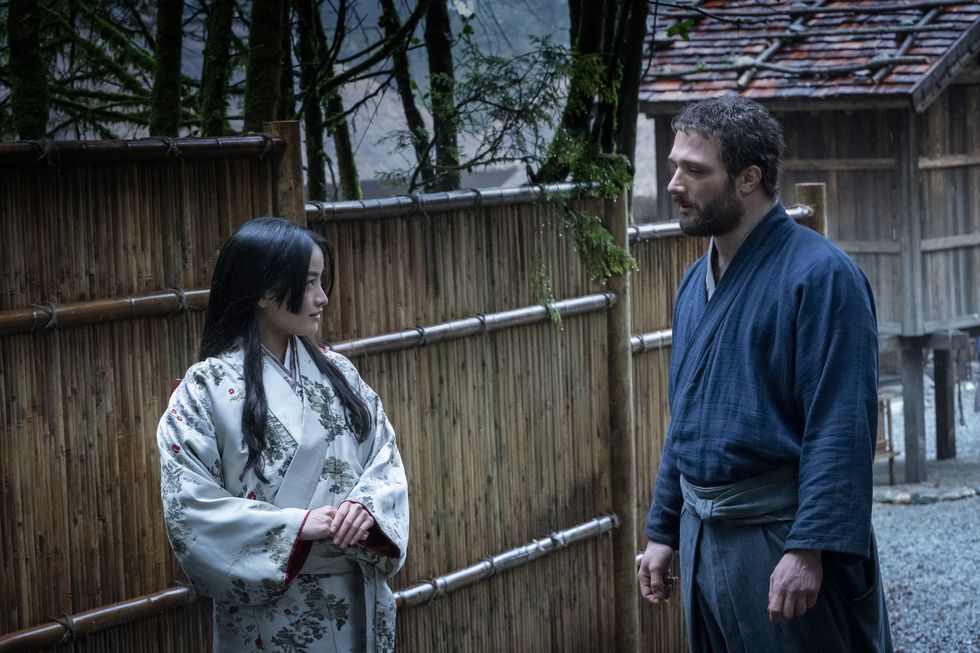Shōgun: Mariko’s Real-Life Counterpart Had a Dark Family History
Spoilers below.
There aren’t many women in Shōgun; set in 16th century feudal Japan, the story, much like the time period, is dominated by male warlords and samurai, while the women are wives, mothers, servants, or housekeepers. Lady Toda Mariko, however, is one of the few exceptions in the series. Played masterfully by Anna Sawai, Toda Mariko is a wife and mother, but she’s also a translator to Lord Yoshii Toranaga, interpreting his conversations with the English “barbarian” John Blackthorne who has become a valuable political asset. In her esteemed role, Mariko has the trust of a powerful lord and an ear in his private conversations and strategy meetings.
Quiet and unflappable, Mariko doesn’t share much about herself at first. But we learn that she is a high-born woman who married Toda Hirokatsu, a.k.a. Buntaro, one of Toranaga’s vassals, and they share a son, Ryûji. She is devoutly Catholic, signified by the rosary around her neck, thanks to the Jesuit presence in Japan. (Catholic Spain and Portugal had established a vast trade network in the country and thus a religious influence as well.) But episode 5 of Shōgun pulls the curtain back on Mariko’s past, revealing a dark family history that mirrors real events that took place long ago in Japan. Here’s what to know about the woman who inspired Lady Mariko.
The character of Mariko is based on the real-life Hosokawa Gracia.
The on-screen Mariko, like the character in James Clavell’s 1975 novel Shōgun, is inspired by Hosokawa Gracia, a Japanese noblewoman and Christian convert.
Born as Akechi Tama in 1563, her father was Akechi Mitsuhide, a warlord and vassal to Oda Nobunaga (one of the great unifiers of Japan in the Sengoku period before Toyotomi Hideyoshi, known as the Taikō in the series), according to Shōgun’s official character guide. She married Hosokawa Tadaoki, another warlord and vassal of Nobunaga, in 1578 and they shared five children together.
Her father was considered a traitor.
In episode 5 of Shōgun, Mariko reveals to Blackthorne the stain on her lineage: Her father, Akechi Jinsai, killed the great leader Kuroda Nobuhisa, who ruled before the Taikō, in a grave act of treason. As a result, he was ordered to kill his own family before committing seppuku, ritual suicide, himself. Mariko, however, was ordered to live by her husband. Her story mirrors Hosokawa Gracia’s.
Gracia’s father, Akechi Mitsuhide, planned to kill Oda Nobunaga at the Honnōji temple in Kyoto. Realizing he had been betrayed, Nobunaga set fire to the temple himself and then committed seppuku. Hideyoshi, then one of Nobunaga’s vassals, responded by defeating Mitsuhide’s army. He eventually sought to rule himself, and eventually became another one of Japan’s great unifiers.
She converted to Catholicism.
After the family tragedy, both Mariko and Gracia turned to Christianity. Gracia was exiled for two years and her reputation was tarnished as the daughter of a traitor, according to Shōgun’s official viewers guide. During this time, she learned about Christianity through her husband as the religion was growing among the warlords’ circles. But she wasn’t allowed to leave her home and actively pursue it. Plus, Hideyoshi had banned Christianity and Jesuits from Japan.
However, in 1587, while her husband was away with Hideyoshi on a military campaign, she secretly visited the church and was baptized as Gracia, according to the guide. Like Mariko, she was converted by the Spanish and Portuguese missionaries in Japan.
Gracia is still honored like a saint. In fact, Mariko’s love story with Blackthorne, considering she was based on a saintly figure, caused ire and offense.
“There’s no doubt that she was a convinced Christian, almost a saint,” George Elison, professor of East Asian languages and cultures at Indiana University, told The New York Times back in 1981, following the mini series broadcast. In that adaptation, “there’s this bizarre business of ‘if it’s natural it has to be good,’ with which she leads the reluctant, prudish English sailor, mind you, into popping into a hot tub together with her,” he added.
She never met the real-life Blackthorne.
According to History Today, Hosokawa Gracia never met William Adams, the actual Englishman Blackthorne is loosely based on. Historian Henry Smith wrote: “[G]ranted that the historical Will Adams never laid eyes on the historical Lady Gracia, was that sort of liaison conceivable in Japan of the year 1600? Here the answer would certainly be that it was not. The daimyo ladies of 16th-century Japan were strictly sequestered and rarely had the chance to meet any men other than immediate family. Nor can one imagine any Japanese woman of good breeding entering the bath so casually with another man–much less a ‘barbarian.’”
In fact, Mariko and Blackthorne’s unlikely romance was criticized by some historians when Shōgun first came out. Smith quotes the historian Edwin Reischauer, who wrote that Clavell “freely distorts historical fact to fit his tale’ when he stoops to having such an ‘exemplary Christian wife’ as Hosokawa Gracia ‘pictured without a shred of plausibility as Blackthorne’s great love, Mariko.”
She wasn’t an interpreter, but she still played an integral role in Japan’s history.
Though she was said to be fluent in Portuguese and Latin, Gracia never served as a translator for Tokugawa Ieyasu (Toranaga in Shōgun), Smith points out. However, according to Smithsonian Magazine, “The book’s portrayal of Mariko’s loyalty to Toranaga is more accurate.”
Gracia’s husband joined forces with Tokugawa for the Battle of Sekigahara. The leader of the opposition, Ishida Mitsunari (Ishido Kazunari in Shōgun), “ordered Gracia to present herself at Osaka Castle as a hostage,” according to writings exhibited by the National Diet Library of Japan. However, she refused and stayed within the Hosokawa residence. She asked a servant kill her before he committed seppuku himself. She was 38 years old.



